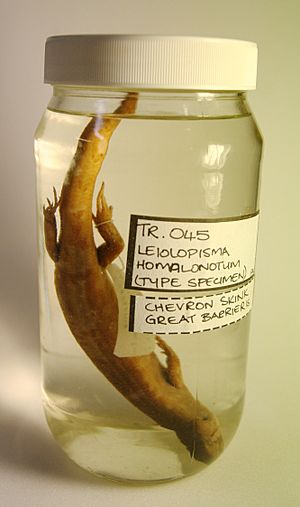Oligosoma homalonotum facts for kids
Quick facts for kids Oligosoma homalonotum |
|
|---|---|
 |
|
| Conservation status | |
| Scientific classification | |
| Genus: |
Oligosoma
|
| Species: |
homalonotum
|

The chevron skink (Oligosoma homalonotum), also known by its Māori name niho taniwha, is a large lizard. It is found only in New Zealand. These skinks live on Great Barrier Island and Little Barrier Island in the Hauraki Gulf. This shy forest animal can hide underwater to escape danger. Sadly, it is threatened by rats that were brought to New Zealand by people.
Contents
Where Chevron Skinks Live
Scientists first described the chevron skink in 1906. The first museum sample was wrongly labeled. It was thought to come from Flat Island. Because of this, the skink was not found again for 70 years. Then, in 1976, a scientist named Hardy found 13 skinks on Great Barrier Island.
It seems chevron skinks once lived on the northern North Island. Old bones of large skinks have been found in places like Tokerau Beach and Waipu. People also reported seeing large lizards in the Hokianga area in the early 1900s. Like many New Zealand lizards, chevron skinks now mostly live on small islands. This is because animals brought by humans, like rats, hunt them.
What Chevron Skinks Look Like
The scientific name "homalonotum" means "smoothed backed." This describes the skink's smooth skin. The chevron skink is light reddish-brown. Its neck and head are grey. It has special black marks under its chin.
The common name "chevron skink" comes from the arrow-shaped marks on its back and tail. These marks all point towards the skink's head. This is the longest lizard in New Zealand. It can grow up to 30 centimeters (about 12 inches) long, including its tail. Its body, from snout to vent, can be up to 14.3 centimeters (about 5.6 inches) long.
Chevron Skink Life and Habits
Chevron skinks are active during the day. But they are very secretive. Their colors help them blend in with ferns or fallen leaves. They need to stay hydrated, so they like to live near streams in forests.
These skinks can go underwater and hold their breath to hide from predators. They also climb plants and hide to escape sudden floods. Young skinks seem to prefer living near rocky streams. They hide in piles of debris or in cracks in rocks. Adult skinks are sometimes found in trees.
Chevron skinks eat small creatures without backbones. These include spiders, insect larvae (like grubs), and tiny snails. Female skinks give birth to live young. They can have up to eight babies in late summer or early autumn.
Protecting Chevron Skinks
By the 1990s, only about 100 chevron skinks had ever been seen. So, the Department of Conservation (DOC) started a project. They wanted to find out how many skinks were left. In 2012, DOC said the chevron skink was "Nationally Vulnerable." This means it is at high risk of becoming extinct.
The biggest group of chevron skinks lives on Great Barrier Island. They are found in at least 20 stream areas. Here, they live alongside pigs, wild cats, mice, and two types of rats. These skinks are very hard to find. Scientists might only find one skink after checking 400 traps over many days.
Efforts to protect them include teaching people about the skinks. They also work to control pigs and other predators in certain areas.
Only two chevron skinks have ever been seen on Hauturu (Little Barrier Island). One was found after more than 20,000 days of trapping! Wild cats have already been removed from Little Barrier Island. DOC has also suggested removing kiore (a type of rat) from the island.


